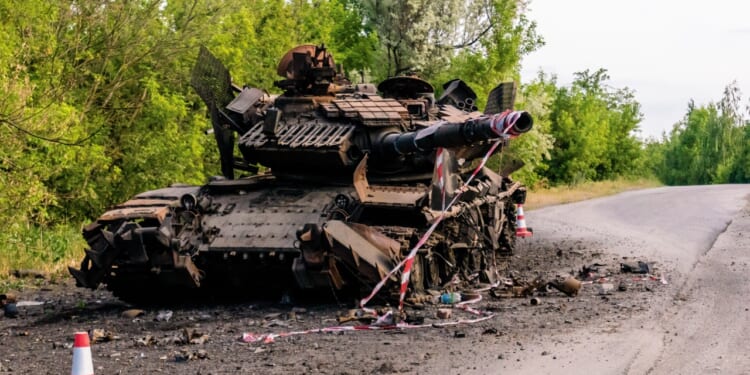The battlefield in eastern Ukraine has destroyed Ukrainian armor at an alarming rate, and NATO tank deliveries to Kyiv have been unable to close the gap.
The Russians are exacting a heavy toll upon the Ukrainians (and, by extension, their NATO backers). In what was once considered a Ukrainian strength, Main Battle Tanks (MBTs), this has now become a dangerous weakness tactically. Ukrainian tank units are reported to be operating far below nominal strength. According to one Ukrainian armored warfare expert, rather than a full battalion of 30 to 40 tanks, many units fighting today has only five or six combat-capable vehicles—some with as few as two.
Essentially, only 20 percent of all Ukrainian tanks are currently combat-ready. This shortfall is occurring, despite the ongoing support from Western militaries in the form of generous tank transfers.
Understanding the Problem of Finite Tanks
Tanks, even older ones, are expensive. These complex systems have become easy targets for new methods of attack, such as drones, ATGMs, and heavy artillery.
Moreover, Ukraine has used its finite tank force copiously on the frontline, meaning that losses would inevitably mount. For Ukraine, the blunt numbers indicate many of the tanks they field have been lost, disabled, or awaiting repair—largely thanks to attrition warfare.
What’s more, Western-supplied tanks bring their own logistical demands that complicate utilization. These tanks require specialized parts, unique training, and laborious servicing to function. Without these factors always at play, even without the damage incurred by combat, maintaining an effective fighting force of Western-provided tanks is simply not possible.
There is also a serious mismatch between available supply and high demand. While allies have committed tanks, the pace of warfare remains so intense—and the volume of need is so high—that resources lag significantly compared to what would be needed to fully equip the Ukrainian tank force. Some tanks may arrive to Ukraine speedily from allied countries, but take time to integrate (again, that crew training, maintenance, and servicing for Western tanks is seriously complicating for the already squeezed Ukrainian Armed Forces).
Consider the much-ballyhooed Leopard I tanks from Germany. Germany sent 178 units of these tanks, but most have not been fully integrated into Ukraine’s Armed Forces—even after more than two years—because, in many cases, the tanks were not delivered to Ukraine in operational condition or at frontline readiness.
Ukraine’s Tanks Just Can’t Keep Up
Between the demands on Ukraine’s forces at the frontline straining their personnel and resources, and the complexities of Western equipment, most of these tanks are struggling to find a place in Ukraine’s beleaguered army.
Ukraine has endeavored to goose its indigenous industrial base (what’s left of it). But because the war is in full heat, and industrial sites are among the most targeted areas in the country, getting an indigenous Ukrainian tank force that could reliably challenge Russia is a very difficult affair for Ukraine.
Let us not forget that the drone threat in Ukraine has become so significant that even tanks, once the king of the modern battlefield, have now been relegated to a proverbial sideshow role because the drones are so effective against tanks. Ukraine is being forced to keep the bulk of their tanks away from main, frontline engagements as a result of Russia’s ubiquitous drones. Therefore, Ukraine’s ability to conduct large-scale armored offensives has been constrained.
Now, as Russia is surging another large tranche of their troops to the Ukrainian front, Russian tank producers are also flowing a new surge of their own tanks to pair with their drones. That combination, at a time when Ukraine’s own tank force is wildly understrength, means that Ukraine could be unable to stop a renewed offensive by those new Russian forces along the front.
Ukraine Needs to Fundamentally Rethink Its War Strategy
Ukraine must rethink its force structure as it continues to lose the war. Shifting tanks into supporting roles, rather than continually trying to use them as shock units along the heavily contested front, while relying more on mechanized infantry as well as combined arms and anti-tank/air defense might slow the loss down.
But the tank shortage increases the value of each remaining tank—each tank becomes more precious, meaning increasing amounts of caution when deploying them, slowing the tempo of any offensive, and reducing the desire for Ukrainian elements to be audacious when fighting.
And the massive depletion of Ukraine’s already finite supply of tanks at the front-end of the war, as with so much of what Ukraine has blown through fighting the Russians, while the Russians maintain the bulk of their MBTs—notably the mighty (though little used) T-14 Armata MBT—means that Ukraine will be made to rely more on their anti-tank weapons and drones to stop any potential Russian offensive with MBTs. Armor will not be able to clash with armor. Here is why the Russians might have been holding their tougher tanks, like the T-14, in reserve for most of the conflict.
The bottom line is simple. Ukraine, which made so much noise about receiving Western tanks, has been unable to make good use of those tanks. It should have instead been focused on other platforms and indigenous capabilities to continue serving as the key insurgency against Russia. Instead, its armed forces have wasted precious finite resources on acquiring those tanks, trying to maintain them, training personnel to use them—all for those tanks to be sidelined or limited in utility.
Ukraine’s tank shortage isn’t just a problem for their war strategy. It’s endemic of an overall set of major flaws with Ukraine’s war strategy—and it likely means Ukraine will never be able to win as Kyiv wants.
About the Author: Brandon J. Weichert
Brandon J. Weichert is a senior national security editor at The National Interest. Recently, Weichert became the host of The National Security Hour on America Outloud News and iHeartRadio, where he discusses national security policy every Wednesday at 8pm Eastern. He is also a contributor at Popular Mechanics and has consulted regularly with various government institutions and private organizations on geopolitical issues. Weichert’s writings have appeared in multiple publications, including The Washington Times, National Review, The American Spectator, MSN, and the Asia Times. His books include Winning Space: How America Remains a Superpower, Biohacked: China’s Race to Control Life, and The Shadow War: Iran’s Quest for Supremacy. His newest book, A Disaster of Our Own Making: How the West Lost Ukraine is available for purchase wherever books are sold. He can be followed via Twitter @WeTheBrandon.
Image: Shutterstock / Jose HERNANDEZ Camera 51.


















